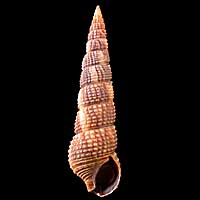|
< Previous family introduction |
|
|||||
 |
Family Cerithiidae Ceriths or Creepers
|
|||||
|
The Cerithiidae is a worldwide family of marine molluscs, most common in shallow water in tropical and subtropical regions. They are found in a range of habitats; sandy and coral areas around coral reefs, sand flats, a few species live in estuarine areas at the seaward side of mangroves, and a few live in deep water. They are microalgal or detritus feeders. Sexes are separate; eggs are laid in gelatinous winding strings attached to the substrate, from which larvae hatch into the plankton. The family is divided into two subfamilies. Shells of the Cerithiinae are large, often with nodulose sculpture, well defined anterior canal, and are generally intertidal in habitat. Most of the tropical species belong to this subfamily. The other subfamily, the Bittiinae, has shells that are usually less than 10 mm in length, more elongate, and have a less well developed anterior canal. Among this subfamily are a few deepwater species. There are nine species known from NSW, with representatives from both subfamilies. Six species of Cerithiinae are tropical species widespread in the Indo-West Pacific region that reach only into the north of the state. One of these, Cerithium coralium, is atypical in that it lives in a muddy habitat, in contrast to the sandy rock or coral habitat of most of the subfamily. The other three species are in the Bittiinae. Two of them, in the genus Cacozeliana, are small but of common occurrence, with a south-eastern and southern Australian distribution. The third species, in the genus Glyptozaria, is a small shell known from deep water of eastern Australia and Japan, but is probably more widely distributed. Family References Houbrick, R.S. 1978. The family Cerithiidae in the Indo-Pacific. Part 1. The genera Rhinoclavis, Pseudovertagus and Clavocerithium. Monographs of Marine Mollusca 1:1-130 Houbrick, R.S. 1985. Genus Clypeomorus Jousseaume (Cerithiidae: Prosobranchia). Smithsonian Contributions to Zoology 403:1-131 Houbrick, R.S. 1992. Monograph of the genus Cerithium Bruguiere in the Indo-Pacific (Cerithiidae: Prosobranchia). Smithsonian Contributions to Zoology 510:1-211 In addition to the species treated in detail, the following tropical species are occasionally recorded in northern NSW: Cerithium columna Sowerby, 1834. Indo-West Pacific; in eastern Australia, to Woolgoolga, NSW. Cerithium egenum Gould, 1849. Indo-West Pacific; in eastern Australia, to Woolgoolga, NSW. Cerithium nesioticum Pilsbry & Vanatta, 1906. Indo-West Pacific; in eastern Australia, to Woolgoolga, NSW. Clypeomorus batillariaeformis Habe & Kosuge, 1966. Indo-West Pacific; in eastern Australia, to Minnie Waters, NSW. Identification Notes Shells of this family are elongate with many whorls, typically sculptured with spiral rows of nodules and axial ridges. There is usually an anterior and posterior canal and expanded outer lip of the body whorl, often with a varix. But these features also apply to the closely related Batillariidae and Potamididae. However, families may be distinguished by the operculum - oval and paucispiral in the Cerithiidae, circular and multispiral in the Batillariidae. |